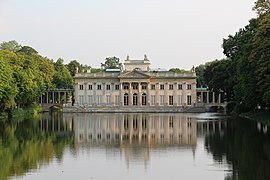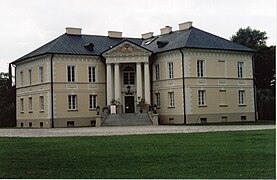Polish Enlightenment
The ideas of the Age of Enlightenment in Poland were developed later than in Western Europe, as the Polish bourgeoisie was weaker, and szlachta (nobility) culture (Sarmatism) together with the Polish–Lithuanian Commonwealth political system (Golden Liberty) were in deep crisis. The period of Polish Enlightenment began in the 1730s–40s, peaked in the reign of Poland's king, Stanisław August Poniatowski (second half of the 18th century), went into decline with the Third Partition of Poland (1795) – a national tragedy inspiring a short period of sentimental writing – and ended in 1822, replaced by Romanticism.[1]
The center of the neoclassical architecture in Poland was Warsaw under the reign of Stanisław August Poniatowski.[2] Classicism came to Poland in the 18th century. The best known architects and artists, who worked in Poland were Dominik Merlini, Jan Chrystian Kamsetzer, Szymon Bogumił Zug, Stanisław Zawadzki, Efraim Szreger, Antonio Corazzi, Jakub Kubicki, Christian Piotr Aigner, Wawrzyniec Gucewicz and Bertel Thorvaldsen.
The first stage, called the Stanislavian style, followed by an almost complete inhibition and a period known as the Congress Kingdom classicism.[3] The most famous buildings of the Stanislavian period include the Royal Castle in Warsaw, rebuilt by Dominik Merlini and Jan Christian Kamsetzer, Palace on the Water, Królikarnia and the palace in Jabłonna.
From the period of the Congress Kingdom are Koniecpolski Palace and the St. Alexander's Church in Warsaw, the Temple of the Sibyl in Puławy, rebuilding the Łańcut Castle. The leading figure in the Congress Kingdom was Antoni Corrazzi.[4] Corazzi has created a complex of Bank Square in Warsaw, the edifices of the Treasury, Revenue and the Commission of Government, the building of the Staszic Palace, Mostowski Palace and designed the Grand Theatre.







